Black and Yellow Spiders (House and Garden Spiders) – Pictures and Identification
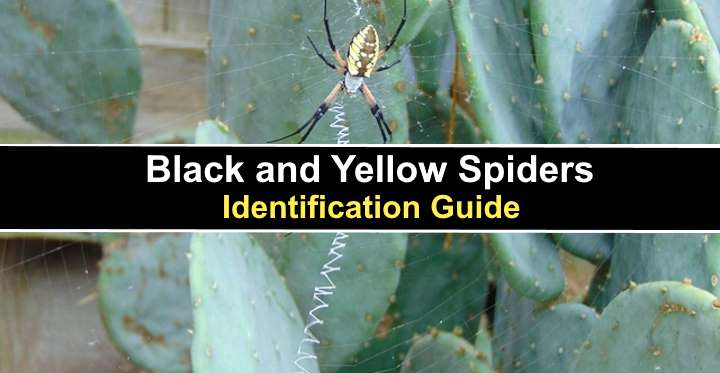
Black and yellow spiders are surprisingly rare. You are more likely to find a yellow and black spider in the garden rather than lurking in the house. The most common spider with a black and yellow body is the garden orb-weaver. This large, oval spider has a black body with yellow markings and striped legs. Other black and yellow spiders are the spiny orb-weaver, arrow-shaped micrathena, and the marbled orb-weaver.
Spotting a black and yellow spider in the garden may send you into panic, thinking that it’s a venomous spider. The vibrant yellow markings on a jet-black body could be mistaken as warning signs. Although the dramatic yellow and black coloring warns off predators, these colorful spiders are rarely dangerous and aggressive.
Have you seen a black and yellow garden spider and want to identify it? If so, please continue reading. This article is a guide to identifying various species of spiders with black and yellow colors. In addition, descriptions of the spider’s features and pictures of spiders will help you recognize unusual spiders in the garden.
Facts About Black and Yellow Spiders
Black and yellow spiders—like all species of spiders—are arthropods in the class Arachnida. All types of spiders have four pairs of legs and two body parts — a cephalothorax and abdomen. This fact differentiates spiders from insects, as insects have six legs and three body parts.
Most species of black and yellow spiders spin webs to catch their prey. The spiders spin circular, or orb-shaped webs, usually between plant stems where bugs and other insects fly into them. Many yellow and black spiders also spin visible zig-zag shapes in the web center.
Although black and yellow spiders can inflict venomous bites, they are rarely aggressive. The only time one may bite is if you inadvertently grab one. The spider’s bite usually only resembles a bee sting and may cause some localized swelling and redness.
How to Identify Black and Yellow Spiders
To identify an individual species of a black and yellow spider, look at its body shape, markings, and see if the spider has bands on its legs and fuzzy hair. For example, black and yellow spiders can have oval, triangular, or crab-shaped bodies.
Types of Black and Yellow Spiders (with Pictures)
Let’s look in detail at characteristics that can help you identify black and yellow spiders you may encounter in the garden or home.
Black and Yellow Garden Orb-Weaver (Argiope aurantia)
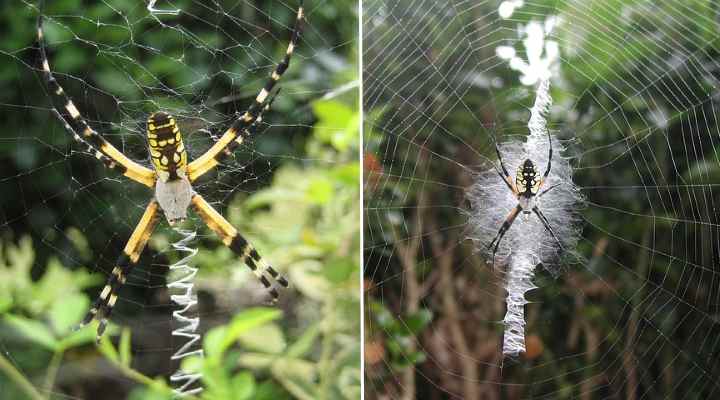
The black and yellow garden orb-weaver is a large spider with long legs that can bite when threatened
The black and yellow garden orb-weaver is identified by its distinctive yellow markings on its black abdomen, banded legs, and oval body. This common garden spider has a small cephalothorax covered in fine silvery hairs. The center of the abdomen has a black mid-stripe and white spots near the top.
Looking at pictures of the yellow garden spider, you’ll notice the long legs are yellow-orange or reddish-brown and have black bands. There are also rows of fine spines along the length of the crooked slender legs. The upper part of the legs appears dark yellow or orange-brown, without noticeable bands.
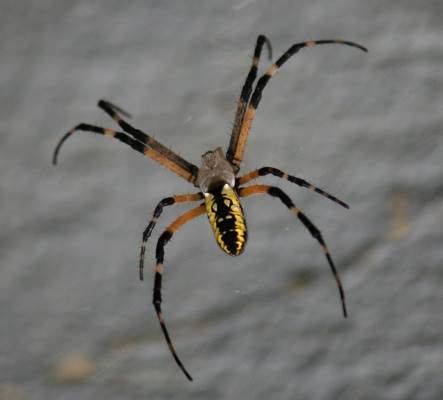
Argiope aurantia close up picture
A recognizable feature of the black and yellow garden spider is that, when resting on its web, it keeps its pair of forelegs and pair of back legs together, giving the appearance of an ‘X’ or the St Andrew’s Cross.
Adult female black and yellow garden orb-weavers measure 1” (25 mm) long with a leg span of up to 3” (70 mm). This means the large garden spider looks like a plump black and yellow grape with huge legs. Typical of most spiders, the males are significantly smaller. The male orb-weaver measures less than 0.25” (6 mm).
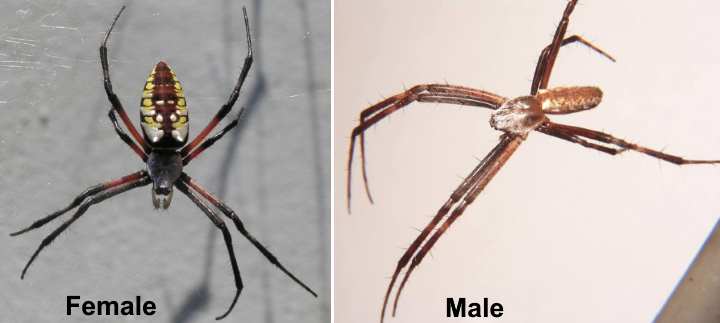
Argiope aurantia female and male
Common names of the Argiope aurantia describe the black and yellow spider’s appearance or habits. Therefore, this spider also goes by names like golden garden spider, yellow garden spider, writing spider, zipper spider, writing spider, zig-zag spider, and black and yellow argiope. You may also hear the spider called McKinley spider, Steeler spider, or corn spider.
The size of a yellow garden spider can be scary. In some states, the large black and yellow garden orb-weaver is the most enormous spider you’ll encounter. Its large black body with yellow and silvery stripes and long legs give it a menacing appearance. However, the yellow spider isn’t dangerous or poisonous and only gives a slight venomous bite if trapped.
Garden orb-weaver web
The black and yellow garden spider gets its name from its colorful markings and intricate web design. The orb webs can be up to 24” (60 cm) in diameter and typically have a zig-zag pattern of silk in the center called a stabilimentum. A web can stay in the same place for the whole summer.
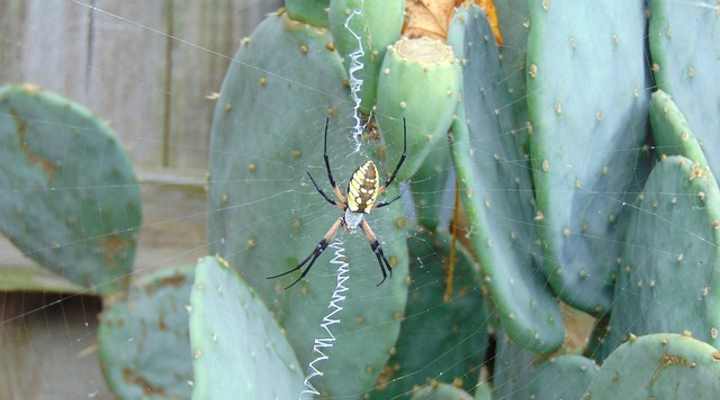
Argiope aurantia is also called zipper spider due to its zigzag web
Adult yellow garden spiders typically spin webs in the evening, attached to shrubs, trees, and herbaceous weeds. The circular webs tend to be high up and directed toward a light source.
Pictures of black and yellow garden orb-weavers often show them sitting head-down in the center of the web. You will also see the distinctive white zig-zag pattern through the center of the web. The spider uses its webs to catch flies, beetles, dragonflies, bugs, grasshoppers, butterflies, and moths.
After trapping prey, the yellow argiope will wrap the bug in silk and then bite into the insect to inject venom and kill it.
Where to find orb-weaver spiders in the garden
You will often find yellow garden spiders in grassy areas near houses. They tend to be active in the morning and evening, constructing and repairing webs. The spiders build their webs on various broad-leafed shrubs, as well as fruit bushes and evergreen conifer bushes.
Benefit in the garden landscape
If you see a black and yellow spider in your garden, it is best to leave it alone. The black and yellow orb-weaver plays a beneficial role in keeping bugs and pests away from your prized ornamental plants and shrubs. The huge garden spider preys on aphids, gnats, mosquitos, grasshoppers, wasps, and bothersome flies.
Garden Orb-Weaver Life Cycle
The life cycle of the black and yellow garden spider starts when the female lays eggs in a teardrop-shaped light brown or white egg sac containing over 1,000 eggs. Each sac is about the size of a ping pong ball. In late summer or fall, the eggs hatch. However, in colder climates, the spiderlings remain in the sac until spring.
Typically, female yellow garden spiders live about one year. However, the female adult can live for several years in warmer climates. The males usually die after mating.
Is a garden orb-weaver venomous?
The yellow and black garden orb-weaver is a venomous spider — however, it’s not a dangerous spider. All spiders contain venom and can bite their prey and humans. But the bite from a yellow and black spider is usually no more severe than a bee sting.
Black and yellow garden orb-weaver identification
The black and yellow garden spider is identified by its small silvery head and large black oval abdomen with a pointed tail end and symmetrical patches of bright yellow markings along its back. Its legs are reddish-brown nearest the body with black and orange or brown bands toward the tips.
Hasselt’s Spiny Spider (Gasteracantha hasselti)
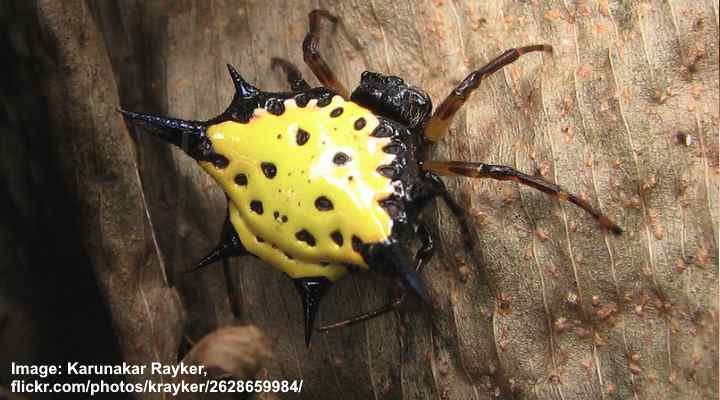
The tiny Hasselt’s spiny spider is easily identified by its 6 black spikes and black dots on its yellow body
The unusual Hasselt’s spiny spider has a bright yellow uniquely-shaped abdomen with several black spots and six large spikes around the margin. Another distinctive feature of the spiny orb-weaver is that its abdomen is wider than it is long. The yellow and black spider is very small, measuring only 0.3” (8 mm) long.
The tiny yellow and black spider is native to Asia and is a type of spiny orb-weaver spider. The characteristic of this spiny orb-weaver is its strange-looking black spikes around its brightly-colored abdomen. In addition, the tiny spider has six dark brown translucent legs.
Looking closely at pictures of this black and yellow spider, you’ll notice a dense covering of fine white hairs. The 12 black spots on the yellow abdomen are arranged in two rows. And the longest two black spikes are at the sides of the body.
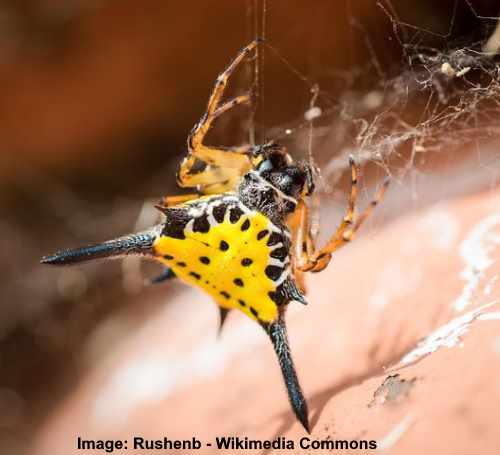
A close up picture of gasteracantha hasselti spider shows that it is covered in fine white hairs
Black and yellow spider identification: The Hasselt’s spiny spider has a brightly colored yellow abdomen with black dots and black spikes around its margins. The small black and yellow spider’s body is relatively hard.
Arrow-Shaped Micrathena (Micrathena sagittata)

The small arrow-shaped Micrathena spider has yellow abdomen with black spots and reddish legs and head
The arrow-shaped micrathena is identified by its striking yellow, black-spotted body. The spider’s abdomen is in the shape of an arrowhead. Visually, the colorful spider has bright yellow, orangey-red, and black colors. Adding to the spider’s unusual appearance are its red legs and red and black spines on its back.
Black and yellow arrow-shaped micrathena spiders are classed as tiny spiders that measure 0.35” (9 mm) long. Up close, you’ll notice that pictures of the brightly-colored yellow abdomen show little black depressions on its back. In addition, the spider has several black and red tubercles on its back.
The botanical name of this black and yellow spider refers to its size and shape. The name means “small, arrow-headed.”
You will often find these bright yellow spiders in Florida gardens and other areas of the eastern United States. In addition, the yellow, black, and red spider is found on shrubs, in forested areas, and backyards. Although the spider has a venomous bite, it won’t harm humans.
Black and yellow spider identification: The arrow-shaped micrathena spider is identified as a small, brightly-colored yellow and black spider with a triangular body, red head, and six reddish legs.
Black and Yellow Marbled Orb-Weaver (Araneus marmoreus)

Black and Yellow Marbled Orb-Weaver (Araneus marmoreus)
The marbled orb-weaver is a colorful spider with a bulbous, egg-shaped body covered in black and yellow patterning. The spider, with its pumpkin-like body, measures between 0.35” – 0.78” (9 – 20 mm). Although orange is the most common color, the marbled-orb weaver also has species with yellow and black abdomens.
Looking at pictures of some marbled orb-weaver species, you’ll notice several identifying characteristics. For example, they have eight eyes arranged in two horizontal rows. In addition, their orangey-brown legs with black and beige bands are covered in fine black spines. Also, the rear legs sometimes look significantly longer than the other crooked legs at the front.
Black and yellow spider identification: The black and yellow marbled orb-weaver is identified by its large, egg-shaped bulbous abdomen with irregular black patterns contrasting on a pale-yellow background. The small spider also has red legs with creamy-white and black bands towards the tips.
Related articles:
- Types of Black Spiders – Identification Guide
- Types of White Spiders – Identification Guide
- Black and Red (or Dark Orange) Spiders
